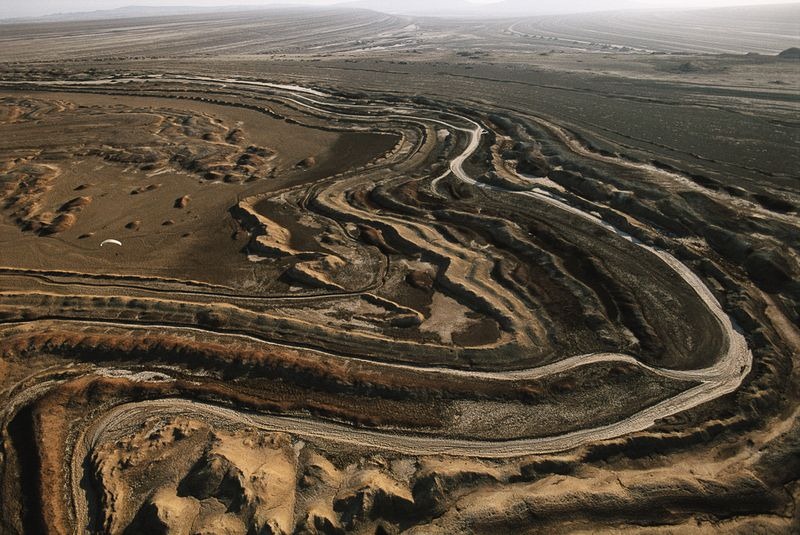Dasht-e Kavir, also known the Great Salt Desert, is a large desert lying in the middle of the Iranian plateau, about 300 kilometers east-southeast of Tehran. The desert is about 800 kilometers long and 320 kilometers wide, and composed of mud and salt marshes (kavirs). Tens of millions of years ago, this region was occupied by a salt-rich ocean that surround a small piece of continent in what is now central Iran. As the ocean dried up, it left behind a layer of salt as much as 6 to 7 kilometers thick.
Over time, the layer of salt was buried under a thick layer of mud. But salt has a fairly low density — lower than the layer of mud and rocks underneath which the salt layer lay. So it started pushing up through the overlying sediment and eventually, over millions of years, the salt broke through and formed domes. The salt domes of Dasht-e Kavir are probably some of the best examples of this geological phenomenon.
Photo credit: George Steinmetz
Geologists have identified about 50 large salt domes in this region. Some of the domes have been eroded away by wind and rain exposing its cross-section.
Although it looks like a hard surface, the salt crust is only a few inches thick, below which lies soft grease-like mud the Iranians called “Charbeh” that is extremely difficult to get out of if one were to get stuck. Because of this travelling in Dasht-e Kavir is extremely dangerous. The soil is sterile and not suitable for cultivation. The desert is almost uninhabited and only partly explored. Human settling is restricted to scattered oases, where wind-blocking housing constructions are raised to deal with the harsh weather conditions. Some live in the hills and the surrounding mountains. Wild sheep, camels, goats and Persian leopards also live in the mountainous areas.
Photo credit: George Steinmetz

Photo credit: George Steinmetz
Photo credit: George Steinmetz
Photo credit: George Steinmetz
An aerial view of the eroded salt dome in the Dasht-e Kavir. Photo credit: Paul Williams
Photo credit: Paul Williams
Salt flats in a low point of the Dasht-e Kavir. Photo credit: George Steinmetz
Strong dry winds have dried the surface of this salt river into a web of hair-like salt crystals. Their orientation preserves a record of the wind as it blew across the surface. Photo credit: George Steinmetz
The surface of a dry salt lake in the Dasht-e Kavir shows signs of a hail or rain storm that pitted its surface. Photo credit: George Steinmetz

Photo credit: George Steinmetz
Photo credit: NASA Landsat 5 satellite
Sources: Wikipedia / NASA / George Steinmetz






















Very interesting and stunning photographs
ReplyDeleteim so hapy to see that beauty of iran is mentioned here but still lots of places are unknown. Alamut valley(valley of assassins) is just one of them .
ReplyDeletei would be more than happy to help any travelers who need information about qazvin and its mysterious places.